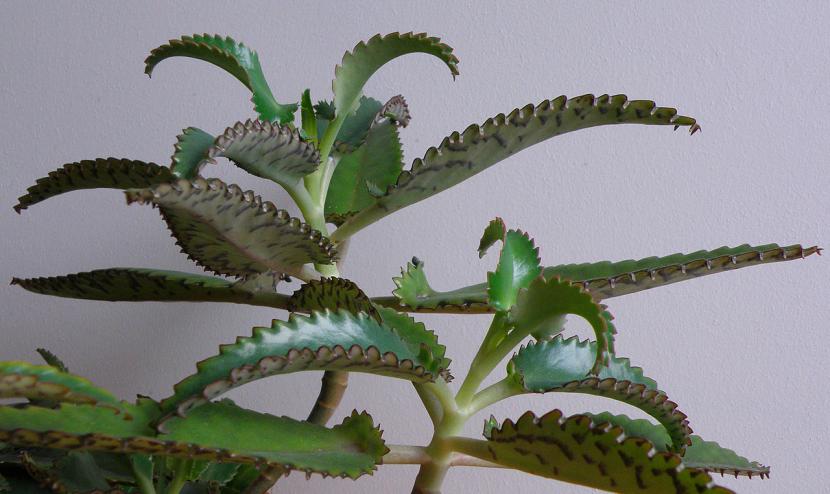
Although the title may be wrong, since the Kalanchoe They are very popular plants in gardens and collections around the world, their medicinal properties are not so well known. Most of us see these crass plants, which have no thorns, as very decorative little plants that are very easy to care for regardless of the experience you have with the plants.
But the truth is that, in addition to being very ornamental, it has recently been discovered that they have very interesting medicinal properties. If you want to know more about them, keep reading.

Kalanchoe daigremontiana
Kalanchoe are a genus of More than 100 species, no spikes. They are native to Europe, Asia, Africa and Australia, but have been naturalized in other parts of the globe. Most grow as herbaceous plants, but there are some that grow as shrubs, such as the Kalanchoe beharensis native to Madagascar and resistant to mild frosts that can reach a height of six meters.
All are suitable for potting, so much so that you can even make compositions of different succulent plants or small cacti by planting them in planters, using a substrate that facilitates drainage (that is, that has perlite, vermiculite or clay). What's more, they are resistant to drought, but they will appreciate a weekly watering in summer and biweekly the rest of the year.

Kalanchoe Gastonis Bonnieri
The Kalanchoe must be located in full sun, as they cannot adapt to living in semi-shade. Most species resist mild frosts, but if you live in a climate where winter is very cold, it is more recommended protect the plant at home during these months, watering only when the substrate is very dry, until the risk of snowfall has passed.
They can be paid from spring to autumn using a specific fertilizer for cacti or, if you want to use it as a medicinal plant, we will necessarily use a natural fertilizer in order not to take unnecessary risks that could endanger our health.

Kalanchoe pinnata
Because there are many species of Kalanchoe, so far only the medicinal properties of the following have been discovered:
- Kalanchoe daigremontiana
- Kalanchoe Gastonnis Bonnieri
- Kalanchoe pinnata
In traditional medicine they are used to:
- Rheumatism
- Gangrenous wounds, deep
- Hypertension
- Kidney colic
- Tumors and abscesses
What are used are the leaves, either as a poultice crushing the leaves and placing them on the affected area, or as an infusion.
What did you think of this "Another face" of the Kalanchoe? Did you know her?
What variety of Kalanchoe is used for diabetes?
Hey.
It is the Kalanchoe daigremontiana.
A greeting.
Hello Monica.
Can you make the Kalanchoe tincture?
And in that case, do you know how to do it?
If it is consumed fresh, for diabetes, how is it administered?
Thank you
Little Star Sobisch
Hello Estrellita.
I have been looking for information and yes you can make tinctures, but you cannot take them directly. It is done in the following way: in the middle of summer the largest leaves are cut, cleaned and cut into pieces of between 3 and 5 cm. Afterwards, they are introduced into glass jars, and ethyl alcohol (96%) is added to cover them.
Finally, the bottle is covered, covered with a paper that keeps it protected from light, and we shake it at least once a day for a week. Thereafter, it can be sneaked.
I don't know how to answer your next questions, I'm sorry.
A greeting.
Hello, for breast cancer which Kalanchoe would help me? And how is it prepared? Thank you!
Hi Alime.
To treat cancer, the Kalanchoe pinnata or Kalanchoe Gastonis Bonieri.
The leaves can be consumed in salads, but before carrying out any treatment it is better to consult an expert.
Greetings, and good cheer 🙂.
I have a kalanchoe like the one in the first photo but the flower is pink and I want to know how I do it so that it flowers again and how to take care of it and what it is for, thank you, I thank you for your attention and receive many blessings